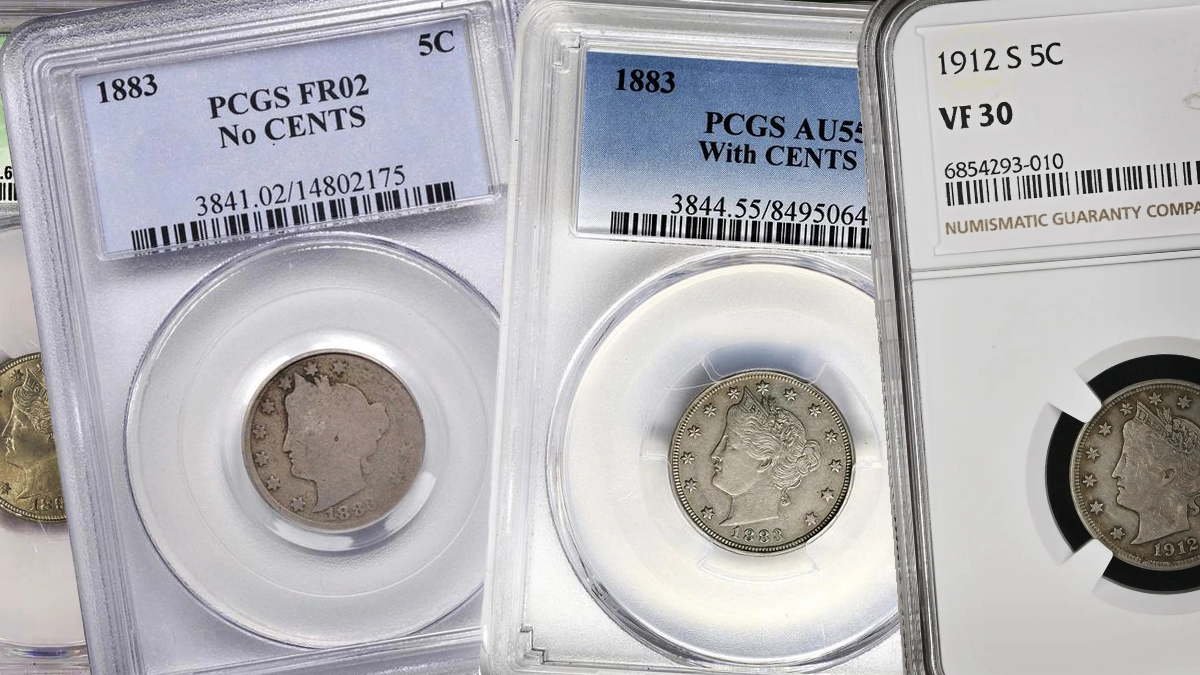
By Greg Reynolds for CoinWeek …..
For more than a half-century, Liberty Nickels have been extremely popular with collectors because they are inexpensive and readily available in a wide range of grades. Liberty Nickels are among the most affordable of all classic U.S. coins.
Beginning, intermediate, and advanced collectors all seem to be attracted to Liberty Nickels. The topic here is circulated Liberty Nickels, those that are noticeably worn. I am referring to Liberty Nickels that grade from Poor-01 to AU-55. In part 2, I will discuss uncirculated (‘Mint State’) and Proof Liberty Nickels.
Liberty Nickels are sometimes called Liberty Head Nickels, and are often informally called ‘V-Nickels’ because the Roman numeral for five (“V”) is the central design element on the reverse, as the face value of each is five cents.
These coins were minted from 1883 to 1913, though the unusual 1913 issue is really a separate topic. Before 1912, all Liberty Nickels were struck at the Philadelphia Mint. In 1912, nickels were struck at the Denver and San Francisco Mints in addition to continued production in Philadelphia.
Until 1942, coins struck at the Philadelphia Mint did not receive mintmarks. Each coin struck in Denver exhibits a ‘D’ mintmark, and an ‘S’ mintmark indicates that a coin was made at the San Francisco Mint. So, including representatives of all three mints in 1912, and two issues in 1883, a set of business strike Liberty Nickels includes 33 coins.
A set of business strikes is not difficult to complete. Before beginning a quest to assemble a set of Liberty Nickels, it makes sense to estimate a budget. Luckily, circulated Liberty Nickels are generally not expensive and actually very cheap in grades below Very Fine-20.
Those familiar with grading terminology may wish to skip the first section. The second section relates to type coins and prices for common date Liberty Nickels. The third section is about building sets of circulated Liberty Nickels. I focus on key dates in the fourth section. In the fifth section, I put forth my concluding thoughts. Comments by John Albanese (CAC) and Kris Oyster (Dallas Gold and Silver Exchange) are included in various sections.
Notes About Grades
Coins are graded on a scale from zero to 70, for traditional rather than logical reasons. It is important not to take the numbers literally. But generally, coins that grade below 60 have readily apparent wear, while business strikes that grade from 60 to 70 are said to be ‘Mint State’ (MS). The term ‘uncirculated’ is nearly synonymous with ‘Mint State’.

The lowest grade, Poor-01, applies to any coin that does not have terrible problems yet is barely identifiable.
A Fair-02 grade coin has much more detail than a Poor-01 grade coin. Outlines of most of the design elements are visible. There should be no doubt as to its design type, though magnification may be required to read numerals.
An Almost Good-03 coin just barely misses qualifying for a Good-04 grade. On Good grade coins, the main design elements (devices) are all present, though will not exhibit much detail. The difference between a Good-04 and a Good-06 grade Liberty Nickel relates largely to rims and borders, which will be weak in general on Good grade coins.
Good condition coins generally are missing parts of their respective rims. Very Good grade coins have rims that are complete or almost so. VG-08 grade Liberty Nickels usually have at least three letter of ‘LIBERTY’ visible in the headband. These might amount to two faint full letters and two half letters. Usually, on a VG-10 grade Liberty Nickel, at least one such letter will be clear and at least three others will be visible, even if just barely.
As for understanding the various gradations of Fine, Very Fine, and Extremely Fine condition coins, viewing pictures online may be very educational. There are plenty of images of nickels on the websites of the major auction firms. Circulated representatives of key date Liberty Nickels, especially the 1885, are often offered at auction. It is typically not worthwhile, however, for a consignor or an auction firm to publicly offer circulated Liberty Nickels of relatively common dates.
Additionally, quality images may also be found on the websites of the major grading services.
Liberty Nickel Type Coins
There are two design types of Liberty Nickels. At first (1883), the reverse of each Liberty Nickel featured the Roman numeral five (V) without any mention of ‘cents’.
Dishonest individuals gold plated these ‘No Cents’ Liberty Nickels and attempted, with some success, to spend them or trade them as five dollar gold pieces (Half Eagles). Liberty Head Half Eagles, which look much different from Liberty Nickels, were minted in substantial quantities and circulated to a significant extent during the early 1880s. Officials from the United States Mint realized there were potential gains and very little to lose by adding the word ‘CENTS’ to the reverse design.
So, 1883 ‘No Cents’ nickels were really just produced for a few months. While ‘No Cents’ nickels constitute a ‘one-year design type’, this first type of Liberty Nickels is not rare, as tens of thousands of them were saved. Coins of the first year of a new design type are typically saved to a great extent as people are excited about new coins, especially designs that have never been seen before. Besides, people were (and still are) curious about the ‘No Cents’ nickels that were sometimes gold plated for fraudulent purposes.
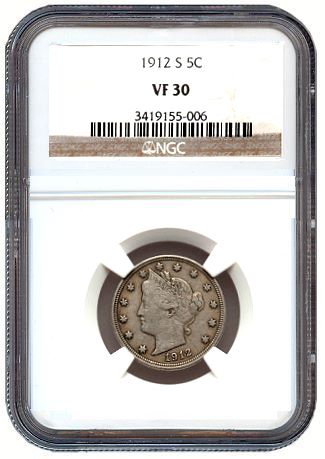
Later in 1883, Liberty Nickels with ‘CENTS’ spelled out in the design were struck. The Latin phrase, E Pluribus Unum, was moved to a location above the wreath. This second design type continued until 1913. The two design types of Liberty Nickels are often referred to as ‘No Cents’ and ‘With Cents.’
Collectors assembling relevant type sets would thus need just two Liberty Nickels. A type set need not include all types of U.S. coins from 1793 to the present. A comprehensive type set of classic coins would include one of each type that was minted from 1793 to 1933. Comprehensive type sets, however, are rare.
Frequently, collectors assemble type sets that are limited to one time period or to one denomination. Many collectors seek to assemble a type set of just 19th-century coins. It is particularly popular to assemble a set of design types that were first minted after 1865 and before 1907.
A type set of just classic nickels is easy to complete, as only five coins are required:
- Three Cent Nickel (1865-83)
- Shield Nickel With Rays on reverse (1866-67)
- Shield Nickel Without Rays (1867-83)
- ‘No Cents’ Liberty Nickel (1883 only)
- ‘With Cents’ Liberty Nickel (1883-1912)
- Buffalo Nickel with “FIVE CENTS” on Mound (Type 1 – 1913 only)
- Buffalo Nickel with “FIVE CENTS” in exergue (Type 2 – 1913-38)
It would not be expensive to add representatives of all types of Jefferson Nickels (1938-present) to such a set, as these are super-common.
While finding an 1883 ‘No Cents’ nickel is not as easy as finding a Jefferson Nickel in change, ‘No Cents’ Liberty Nickels are common. My retail price guide follows: Poor-01 ($1.50), Fair-02 ($3), AG-03 ($4), Good-04 ($6), Good-06 ($7), VG-08 ($8.50), VG-10 ($9), Fine-12 ($10), F-15 ($10.50), VF-20 ($12), VF-30 ($12.50), EF-40 ($13.50), AU-50 ($14.25), AU-55 ($15.50), AU-58 ($22).
For the ‘With Cents’ type, a collector seeking just one coin would be likely to choose a common date. Liberty Nickels dating from 1897 to 1911 tend to be common, though this is not always true, certainly not for all grades. Personally, I suggest an 1899 as a selection for a type set. It is fun to acquire a 19th-century coin and the 1899 is truly common. Collectors should be able to pick an 1899 that is appealing for its respective grade, from Fair-02 to AU-55 or beyond.
Generally, Liberty Nickels of the early 1900s are chosen for type sets. My retail price guide for common, ‘With Cents’ Liberty Nickels follows: Poor-01 ($0.75), Fair-02 ($1), AG-03 ($1.45), Good-04 ($1.95), Good-06 ($2.25), VG-08 ($3) VG-10 ($3.50), Fine-12 ($5.25), F-15 ($6.50), VF-20 ($11), VF-30 ($17.50), EF-40 ($34), EF-45 ($42), AU-50 ($50 to $60), AU-55 ($65 to $85), PCGS- or NGC-graded AU-58 ($70 to $110). It is important to remember that these estimates of market values are for very common dates.
Also, I am referring to coins that are relatively ‘problem-free’ for their respective grades. Coins with serious problems are worth much less than these values.
In general, factors relating to specific transactions result in Liberty Nickels selling for more or less than the market values for coins that are ‘average’ for their respective grades. Price guides should not be interpreted as being precise. Importantly, the aesthetic characteristics and/or surface quality of individual coins may result in any respective price being higher or lower than the average price for a given type, date, and grade.
Building Sets
Collectors on a budget and collectors who really like heavily circulated coins will tend towards Liberty Nickels that grade from Good-04 to Fine-15. The whole set could be completed in Good-04 grade for less than $1,000, perhaps much less. Over a four-year period, such a set would thus require an expenditure of maybe $250 per year–hardly a fortune. In Fine-12 grade, a whole set of 33 business strikes may cost around twice as much, $2,000.
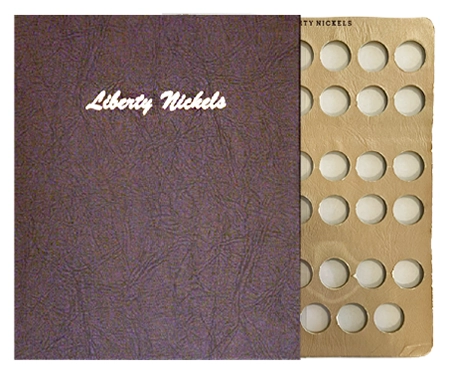
John Albanese points out that “many AG and Good pieces have edge problems or rough surfaces.” He recommends Liberty Nickels in “full VG” rather than those that grade on or near the border of Good-06 and VG-08.
Albanese continues: “When I was a kid, I would try hard to get Liberty Nickels in Fine because they have full ‘LIBERTY.’ As a collector, it is nice to see all the letters.”
Kris Oyster states that “Liberty Nickels in Good are very, very common. In Very Fine to [Extremely] Fine, they become much harder to find.”
In my view, a collector who does not wish to spend much should consider obtaining common dates in Fine or better grades and relatively scarce dates in Good grades. A set built in this manner would cost much less than $2,000. After all, in the previous section, I mention that common dates may be purchased for $5.25 or so in Fine-12 grade and around $11 in VF-20 grade.
Albanese and Oyster both say, and I agree, that Liberty Nickels in Good grades are so heavily worn that “it is hard to appreciate” the design. While it may make sense for collectors on a budget to acquire key dates in Good-04 or lower grades, all collectors may wish to acquire a few common dates in higher grades. In the above section on type coins, I provide rough estimates of the values of common dates in most circulated grades. A few common dates are not as common as others and will cost a little more than these estimates – such as the 1897, the 1898, and the 1909.
A collector on a budget could be happy with most Liberty Nickels in Fair-02 to Good-04 grades, along with a few in VF-20 to EF-40 grades. When I was a kid, I was thrilled with better dates that graded Fair-02 or AG-03. When I wished to appreciate the design, I examined my EF-40 or -45 grade common dates. I liked my Liberty Nickels, even one better date that barely grades Poor-01. I was enthusiastic about acquiring additional dates and working towards completing a set.
While the 1885, the 1886, and the 1912-S are the keys, there are others that are ‘better dates’ and are worth considerably more than common dates. The 1888 is a semi-key that may cost more than $20 in Good-04 condition and more than $60 in Fine-12 grade.
All the Liberty Nickels dating from 1891 to 1896 are worth substantially more than common dates. These may cost from $6 to $20 each in Good-04 grade. Most of these six dates will cost from $20 to $40 in Fine-12, except the 1894, which may cost $100! A budget-minded collector could find an 1894 in Fair-02 or AG-03 grade for around $6.
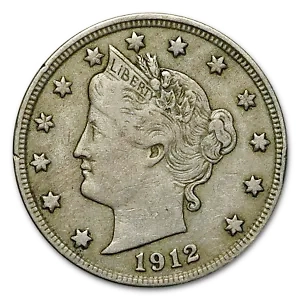
In 1912, the Denver and San Francisco Mints began producing nickels. A 1912-D may cost $3.50, more or less, in Good-04 grade and around $12 in Fine-12 grade. I repeat that the estimated values provided here are just approximations. Actual coins may cost more or less, depending upon several factors.
When analyzing grade distributions of Liberty Nickels, I am reminded of Barber Half Dollars, one of my favorite series. Barbers Halves are plentiful in Good through Fine grades and are readily available in MS-62 to MS-64 grades. These are not easy to find, however, in Extremely Fine-40 to AU-53 grades. Either Barber Halves extensively circulated for decades or they were set aside soon after being minted. In this manner, Liberty Nickels are like Barber Halves.
In Extremely Fine and AU grades, better date Liberty Nickels tend to cost more than twice as much as the common dates. So, a budget-minded collector who already decided to buy the common dates in EF or AU grades may buy some of the better dates in lower grades, depending upon his or her budget and tastes. There is no rule that states that all the coins in a set must fall into a narrow grade range.
Key Date Liberty Nickels
In the series of Liberty Nickels, each of the three key dates is priced much higher than each of the rest of the dates. The keys are the 1885, the 1886, and the 1912-S.
Other than the enigmatic 1913, the 1885 is the prize of the series. I recommend acquiring 1885 nickels that are PCGS- or NGC-graded. I am not referring here to ‘so called’ details ‘grades’. I am suggesting obtaining 1885 nickels with true numerical grades stated on PCGS or NGC holders.
Coins that merit numerical grades are worth considerably more than those that have problems that preclude the assignment of numerical grades. The problems are sometimes not obvious, especially not to beginning collectors.
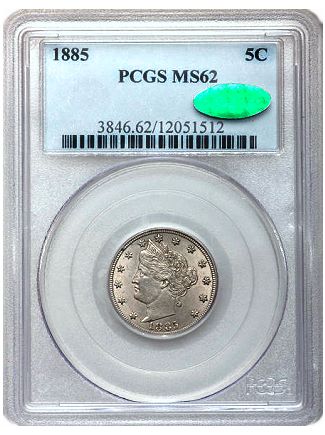
Kris Oyster finds that many collectors buy key date Liberty Nickels that are not certified, and he says that acquiring not-certified 1886 nickels is sensible.
“For 1885 or 1886 Liberty Nickels, make sure you are buying from a reputable dealer,” Oyster asserts.
My estimates of retail prices for PCGS- or NGC-graded 1885 Liberty Nickels are, as follows: Poor-01 $170; Fair-02 $215; AG-03 $340; Good-04 $575; Good-06 $625; VG-08 $685; VG-10 $715; Fine-12 $855; F-15 $900; VF-20 $1,100; VF-30 $1,200; EF-40 $1,450; EF-45 $1,570; AU-50 $1,850; AU-55 $2,125; AU-58 $2,475.
I emphasize that these are retail levels, regarding situations where collectors have the opportunity to examine each coin before deciding as to whether to buy it. Pertinent auction prices will usually be lower than the values that I listed.
The 1886 is relatively scarce, too. Prices for circulated 1886 nickels, however, tend to be only 40% to 50% of the corresponding prices for 1885 nickels. Prices for the 1912-S are lower than those for the 1886 until the EF-40 grade level is reached, at which point 1912-S nickels start becoming more expensive than 1886 nickels, though not nearly as expensive as 1885 nickels.
“For a 1912-S, go for a VF, if you can afford it, a VF is much better value than a VG or Fine 1912-S,” asserts John Albanese. In terms of retail prices, a 1912-S may be worth around $155 in Good-04 grade, $170 in VG-08, $240 in Fine-12, and $535 in VF-20 grade.
“I would have much rather have a 1912-S nickel in Gem than a 1909-S VDB penny,” Albanese declares. “There has got to be more survivors of ’09-S VDB pennies than 12-S nickels. I would guess that there are more than one hundred thousand ’09-S VDB pennies. [Furthermore,] the average grade of a ’12-S nickel is a lot lower. Absolutely, in EF-40 grade, a ’12-S nickel is a better value than a 1909-S VDB penny,” John concludes.
The 1912-S nickel has a retail value of around $975 in EF-40 grade, while a 1909-S VDB Lincoln Cent, the most famous of all cents, has a retail value of more than $1,100 in EF-40 grade. Albanese is suggesting, though, that even if a 1912-S nickel and a 1909-S VDB cent sold for the same prices in the same grades, 1912-S nickels would still be better buys for collectors.
Albanese has a positive view of all three of the keys in EF-40 grade.
“Extremely Fine, key date Liberty Nickels are good values,” John says. “These are hard to find, better values than key date Lincoln Cents.”
In EF-40 grade, the 1886 may cost around $740. In contrast, an 1886 in Fair-02 grade is worth under $100. A Good-04 1886 may be found for less than $300, possibly even for less than $250. A Fine-12 grade 1886 may retail for around $425. I repeat that collectors should buy 1885 and 1886 Liberty Nickels that are PCGS- or NGC-graded.
Concluding Thoughts
For budget-minded collectors and/or beginning collectors, Liberty Nickels are excellent choices. These are not rare. Available Liberty Nickels are characterized by a wide range of grades, degrees of originality, and aesthetic characteristics.
Collectors who search and investigate may acquire Liberty Nickels for prices well below retail levels. Such finds will usually require time.
Visiting small coin shops and relatively small coin shows will often lead to seeing a substantial number of Liberty Nickels.
“When coin shops have Liberty Nickels in stock, collectors should try to negotiate because these don’t move fast and coin shop owners don’t usually pay a lot for them,” Albanese reveals. “You can almost assume that their costs are well below wholesale,” John notes.
When a dealer has an order or a client in mind for specific Liberty Nickels, he may pay prices that are well within the wholesale range. When a local coin shop buys a collection or an accumulation that includes many Liberty Nickels, the proprietor of the shop will tend to pay amounts that are much lower than wholesale prices. As Albanese suggests, it may take a long time for a dealer to sell an inventory of circulated Liberty Nickels, especially of common and ‘slightly better’ dates. After all, it is usually not cost-effective to list these in advertisements or to post descriptions along with quality images of circulated Liberty Nickels on a website. While a collector may find many Liberty Nickels at shops and shows, he or she should be careful.
Most collectors are not expert graders. A collector of Liberty Nickels should not expect to become an all-star grader. He or she, though, may wish to learn how to spot edge dents, rim problems, corrosion, severe cleanings, repairs, blatantly artificial toning, auto body putty, and other issues. Usually, however, coin doctors do not bother to take the time to ‘modify’ circulated Liberty Nickels. They tamper with more expensive coins.
Plus, severe cleaning and repairs of circulated Liberty Nickels are often obvious, as are most edge problems. Collecting circulated Liberty Nickels does not involve much risk and collectors of these should not worry about them. Collecting Liberty Nickels is relaxing.
Liberty Nickels are the best choices for non-rich people who especially like nickels and wish to get started collecting classic U.S. coins. Naturally toned Liberty Nickels of all dates are available, in multiple grades. Just a small budget is needed. A set of circulated Liberty Nickels is easy and fun to complete.
The story continues in Part Two of this article: An Introduction to Liberty Nickels, Part 2: Uncirculated Coins
* * *





LOUIS, Is the Liberty nickel the one with the “V” on the reverse? This is very strange, I just received a 1900 in my change last week.The date is barely legible and with my bad eyesight, I think this is the date that I see. But it is in “vg” or just “g” of a grade. From first looking at it, I thought it was a slug. It also feels like some silver might be in it.
It’s a Liberty V nickel and they did not have silver in them. Finding one in circulation after all of these years is quite rare- but not impossible.
Thanks.